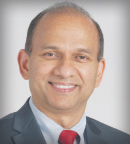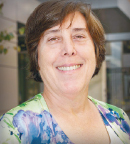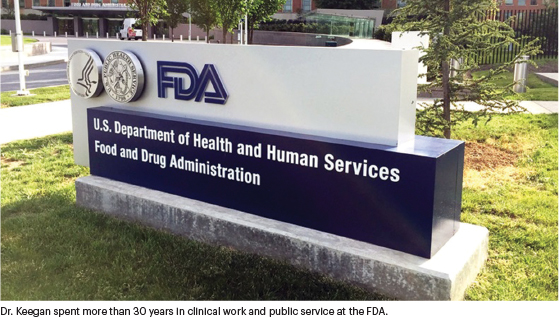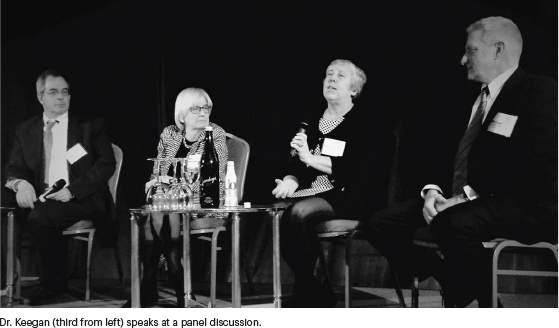In this installment of the Living a Full Life series, guest editor Jame Abraham, MD, spoke with Patricia Keegan, MD, who served at the U.S. Food and Drug Administration (FDA) for 30 years, most recently as Acting Associate Director of Medical Policy at the Oncology Center for Excellence (OCE). Prior to serving at the FDA, Dr. Keegan was Clinical Assistant Professor and a medical oncologist at the University of North Carolina at Chapel Hill. Dr. Keegan recently transitioned to industry, where she will serve as Chief Medical Officer at TopAlliance Biosciences.
GUEST EDITOR

Jame Abraham, MD, FACP
Patricia Keegan, MD, was born in Pensacola, the westernmost city in the Florida Panhandle, which is also home to one of the many U.S. naval bases where her father was stationed during his military service. “I am the second oldest of seven girls, and when I was young, my father’s service in the Navy required that we move about quite a bit, to different bases. We lived in several in California, in one off the coast of Washington, and ultimately in Chicago, where he left the Navy to pursue higher education,” said Dr. Keegan.
A Career Inspired by Books and Stories
Dr. Keegan’s keen interest in medicine bloomed as a young girl in elementary school. Her mother nurtured her daughter’s nascent calling with science books and personal stories. “My mother bought me a lot of books dealing with science. One that stood out was a series called How and Why, which offered fascinating forays into different scientific areas. It was published in small paperbacks, and I remember devouring each one. As soon as I finished one, I couldn’t wait for the next edition,” she added.
Dr. Keegan continued: “My mother contracted polio during her adolescent years, and she related stories about her experiences, one of which was how well she was cared for by her pediatrician, who was a woman—pretty rare for that time in our history. The stories about her pediatrician definitely inspired me and gave me confidence that I could pursue a career in medicine if that’s what I wanted. All said, looking back I realize since I was a kid, I always wanted to become a doctor.”
After graduating high school, Dr. Keegan attended the University of Illinois at Urbana for her undergraduate degree. She then pursued her medical degree at Loyola Medical School, where, after what Dr. Keegan described as “a wonderful experience,” she remained to do her internal medicine residency.
Dr. Abraham asked what inspired her desire to pursue a career in oncology, and Dr. Keegan replied: “While I was doing my residency, I was mentored by the institution’s head of medical oncology, Dr. Ketty Badrinath. He was just a delightful guy—a very practical, down-to-earth human being—who had a wonderful way of dealing with patients with cancer, being both clinically sound and sympathetic at the same time. I really enjoyed working with him and learning the nuances of patient care in such vulnerable populations.”
PATRICIA KEEGAN, MD

On her first mentor: “[Dr. Bandenap] was just a really delightful guy—a very practical, down-to-earth human being—who had a wonderful way of dealing with patients with cancer, being both very clinically sound and sympathetic at the same time.”
On working in drug development: “It is always a thrill to evaluate a new drug’s clinical trial results and determine whether an agent makes it onto the public marketplace, and into the hands of oncologists who treat our patients with cancer.”
On her advice for young oncologists: “In academic medicine and public health service, such as the FDA, it is a marathon not a sprint. Drug development is hugely satisfying for those who love science. But it is a long and sometimes frustrating path.”
Making a Difference
Dr. Keegan noted that a patient with cancer also ignited her desire to become an oncologist. “When I was a medical student, there was a young girl who had been diagnosed with acute leukemia, and our treatments put her life-threatening disease into remission. I remember with crystal-clear thinking, other than infectious disease, there are not many disciplines in medicine in which somebody comes in very sick, and with our science and medical lens of the world, you can reach into an incredible medical toolbox and cure them. I thought that being in oncology would be a fabulous opportunity to change people’s lives for the better. So, being influenced by that patient with cancer and also by Dr. Badrinath, who was an incredible oncologist who always sought to make a difference in the world, I decided that oncology was where I wanted to be. I think that’s kind of been the theme of my professional life: always wanting to be somewhere where I can make a difference.”
After completing her medical oncology fellowship at Roswell Park Memorial Institute, Buffalo, New York, Dr. Keegan took a position on the faculty of the Division of Medical Oncology at the University of North Carolina (UNC) at Chapel Hill. “Shortly after joining Roswell Park as a fellow, I met my husband, who was working on his PhD and also doing research with Dr. Howard Ozer. We weren’t married at the time, and when Dr. Ozer left Roswell Park to go to UNC, my future husband, who wasn’t yet finished with his doctoral work, went with him. I also joined Dr. Ozer on the faculty at UNC, where I worked for 4½ years in the medical oncology department. My primary focus was in head and neck cancer, because there was a lot of tobacco use there at the time, which resulted in an unmet clinical need I hoped to help fill,” said Dr. Keegan.
Pivot to Drug Development
After Dr. Keegan’s husband completed his PhD, he did some postdoctoral work at UNC. After a while, the newly married couple decided it was time for a career move that would offer them new challenges and exciting opportunities. “At the time, a friend of mine was working at the FDA and she told me I should consider looking into it. So, I interviewed with Janet Woodcock, who was Director of the Agency’s Division of Biological Investigational New Drugs, and she told me there might be an opportunity to work on a new drug being investigated for oncology. It sounded intriguing from an intellectual perspective, so I took the position. Although I loved patient care, which is the reason I continued to work in the FDA breast clinic as long as I could, my responsibilities in drug development eventually became my sole focus,” said Dr. Keegan.

Advice for Young Oncologists
Asked what she found most gratifying at the FDA, Dr. Keegan said: “When I interviewed people interested in joining the FDA, I would tell them that I personally found it extremely gratifying to work with talented scientists within the FDA along with those from industry to develop life-saving cancer drugs that will benefit the American public. As a clinician/scientist working for the U.S. government, it is always a thrill to evaluate a new drug’s clinical trial results and determine whether an agent makes it onto the public marketplace and into the hands of oncologists who treat our patients with cancer.”
Any advice for bright young oncologists thinking about a future in the FDA? “I think young people in this field need to fully analyze the reality of their choices and do some soul-searching as well. There is a great allure to clinical oncology—an instant, hands-on gratification of treating patients with cancer. In academic medicine and public health service, such as the FDA, it is a marathon not a sprint. Drug development is hugely satisfying for those who love science. But it is a long and sometimes frustrating path, and ultimately, if you are not interested in the long-term, somewhat abstract goals of public health, it just might not be for you.”
Another Career Opportunity
After more than 30 years in clinical work and public service at the FDA, Dr. Keegan has added another chapter to her noted career: serving as an industry leader. As Chief Medical Officer of TopAlliance Biosciences, she will provide leadership and supervision for the company’s clinical development plans and act as a key member of the senior management team that sets the overall strategic direction of the company. “This latest move has offered me a place where I combine my skill sets in clinical work and research with my regulatory knowledge to add to a very exciting portfolio of development opportunities. And, once again, it’s a place where I think I can provide leadership in a way that truly makes a difference,” said Dr. Keegan.

Balancing Work and Personal Life
How does a super busy leader in industry decompress and maintain a personal and professional balance? “Oh my!” she responded. “Well, my husband retired a while ago, and that took off some of the pressures of work-life balance for me. But I think one of the things is trying to decide how to parse out your time. We have four kids and a large extended family as well, so being able to be involved with some family matters is important to my sense of balance. But as my kids have gotten older, I can get back to doing more things, such as taking time for myself, taking classes, and doing more traveling, which I hope to do at some point given the current challenges. Life is busy, but it is very rewarding, so if you love what you do, it sort of balances out naturally.”

